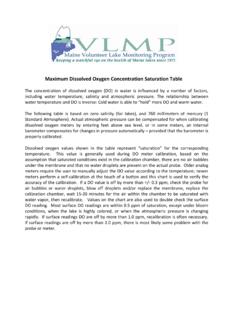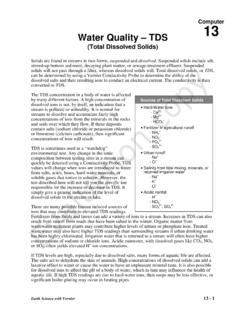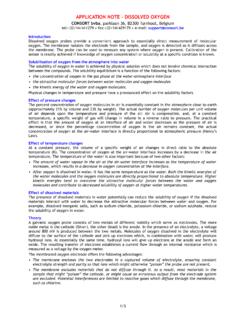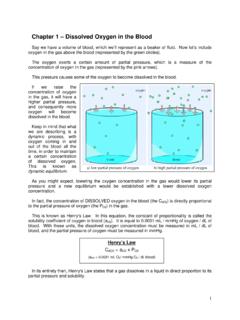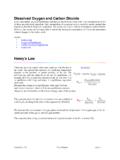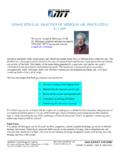Transcription of Total dissolved solids in Drinking-water - WHO
1 WHO/SDE/ onlyTotal dissolved solids in Drinking-waterBackground document for development ofWHO Guidelines for Drinking-water Quality_____Originally published in Guidelines for Drinking-water quality, 2nd ed. Vol. 2. Health criteria andother supporting information. World Health Organization, Geneva, 1996. World Health Organization 2003 All rights reserved. Publications of the World Health Organization can be obtained from Marketing andDissemination, World Health Organization, 20 Avenue Appia, 1211 Geneva 27, Switzerland (tel: +4122 791 2476; fax: +41 22 791 4857; email: for permission to reproduce or translate WHO publications - whether for sale or fornoncommercial distribution - should be addressed to Publications, at the above address (fax: +41 22791 4806; email: designations employed and the presentation of the material in this publication do not imply theexpression of any opinion whatsoever on the part of the World Health Organization concerning thelegal status of any country, territory, city or area or of its authorities, or concerning the delimitation ofits frontiers or mention of specific companies or of certain manufacturers products does not imply that they areendorsed or recommended by the World Health Organization in preference to others of a similar naturethat are not mentioned.))
2 Errors and omissions excepted, the names of proprietary products aredistinguished by initial capital World Health Organization does not warrant that the information contained in this publication iscomplete and correct and shall not be liable for any damages incurred as a result of its usePrefaceOne of the primary goals of WHO and its member states is that all people, whatevertheir stage of development and their social and economic conditions, have the right tohave access to an adequate supply of safe drinking water. A major WHO function toachieve such goals is the responsibility to propose regulations, and to makerecommendations with respect to international health matters .. The first WHO document dealing specifically with public Drinking-water quality waspublished in 1958 as International Standards for Drinking-water . It was subsequentlyrevised in 1963 and in 1971 under the same title. In 1984 1985, the first edition of theWHO Guidelines for Drinking-water quality (GDWQ) was published in threevolumes: Volume 1, Recommendations; Volume 2, Health criteria and othersupporting information; and Volume 3, Surveillance and control of communitysupplies.
3 Second editions of these volumes were published in 1993, 1996 and 1997,respectively. Addenda to Volumes 1 and 2 of the second edition were published in1998, addressing selected chemicals. An addendum on microbiological aspectsreviewing selected microorganisms was published in GDWQ are subject to a rolling revision process. Through this process, microbial,chemical and radiological aspects of Drinking-water are subject to periodic review,and documentation related to aspects of protection and control of public Drinking-water quality is accordingly the first edition of the GDWQ, WHO has published information on healthcriteria and other supporting information to the GDWQ, describing the approachesused in deriving guideline values and presenting critical reviews and evaluations ofthe effects on human health of the substances or contaminants examined in each chemical contaminant or substance considered, a lead institution prepared ahealth criteria document evaluating the risks for human health from exposure to theparticular chemical in Drinking-water .
4 Institutions from Canada, Denmark, Finland,France, Germany, Italy, Japan, Netherlands, Norway, Poland, Sweden, UnitedKingdom and United States of America prepared the requested health the responsibility of the coordinators for a group of chemicals considered in theguidelines, the draft health criteria documents were submitted to a number ofscientific institutions and selected experts for peer review. Comments were taken intoconsideration by the coordinators and authors before the documents were submittedfor final evaluation by the experts meetings. A final task force meeting reviewed thehealth risk assessments and public and peer review comments and, where appropriate,decided upon guideline values. During preparation of the third edition of the GDWQ,it was decided to include a public review via the world wide web in the process ofdevelopment of the health criteria the preparation of health criteria documents and at experts meetings, carefulconsideration was given to information available in previous risk assessments carriedout by the International Programme on Chemical Safety, in its Environmental HealthCriteria monographs and Concise International Chemical Assessment Documents, theInternational Agency for Research on Cancer, the joint FAO/WHO Meetings onPesticide Residues, and the joint FAO/WHO Expert Committee on Food Additives(which evaluates contaminants such as lead, cadmium, nitrate and nitrite in addition tofood additives).
5 Further up-to-date information on the GDWQ and the process of their development isavailable on the WHO internet site and in the current edition of the work of the following coordinators was crucial in the development of thisbackground document for development of WHO Guidelines for drinking- Fawell, Water Research Centre, United Kingdom (inorganic constituents)U. Lund, Water Quality Institute, Denmark (organic constituents and pesticides)B. Mintz, Environmental Protection Agency, USA (disinfectants and disinfectant by-products)The WHO coordinators were as follows:Headquarters:H. Galal-Gorchev, International Programme on Chemical SafetyR. Helmer, Division of Environmental HealthRegional Office for Europe:X. Bonnefoy, Environment and HealthO. Espinoza, Environment and HealthMs Marla Sheffer of Ottawa, Canada, was responsible for the scientific editing of efforts of all who helped in the preparation and finalization of this document,including those who drafted and peer reviewed drafts, are gratefully convening of the experts meetings was made possible by the financial support afforded toWHO by the Danish International Development Agency (DANIDA), Norwegian Agency forDevelopment Cooperation (NORAD), the United Kingdom Overseas DevelopmentAdministration (ODA) and the Water Services Association in the United Kingdom, theSwedish International Development Authority (SIDA), and the following sponsoringcountries.
6 Belgium, Canada, France, Italy, Japan, Netherlands, United Kingdom of GreatBritain and Northern Ireland and United States of DESCRIPTIONI dentityTotal dissolved solids (TDS) is the term used to describe the inorganic salts and smallamounts of organic matter present in solution in water. The principal constituents are usuallycalcium, magnesium, sodium, and potassium cations and carbonate, hydrogencarbonate,chloride, sulfate, and nitrate propertiesThe presence of dissolved solids in water may affect its taste (1). The palatability of Drinking-water has been rated by panels of tasters in relation to its TDS level as follows: excellent, lessthan 300 mg/litre; good, between 300 and 600 mg/litre; fair, between 600 and 900 mg/litre;poor, between 900 and 1200 mg/litre; and unacceptable, greater than 1200 mg/litre (1). Waterwith extremely low concentrations of TDS may also be unacceptable because of its flat,insipid METHODSThe method of determining TDS in water supplies most commonly used is the measurementof specific conductivity with a conductivity probe that detects the presence of ions in measurements are converted into TDS values by means of a factor that varieswith the type of water (2,3).
7 The practical quantitation limit for TDS in water by this methodis 10 mg/litre (M. Forbes, personal communication, 1988). High TDS concentrations can alsobe measured gravimetrically, although volatile organic compounds are lost by this method(4). The constituents of TDS can also be measured LEVELS AND HUMAN EXPOSUREW aterTDS in water supplies originate from natural sources, sewage, urban and agricultural run-off,and industrial wastewater. Salts used for road de-icing can also contribute to the TDS loadingof water of TDS from natural sources have been found to vary from less than 30mg/litre to as much as 6000 mg/litre (5), depending on the solubilities of minerals in differentgeological regions. Thus values, expressed as the sum of the constituents, were below 500mg/litre in 36 of 41 rivers monitored in Canada (6), while, in a survey of the Great Lakes,levels ranged from 65 to 227 mg/litre (7). The levels of TDS in all of the Great Lakes exceptLake Superior have increased in the last 70 years, by 50 60 mg/litre in Lakes Erie andOntario (7 10).
8 Between 1960 and 1980, a threefold increase in TDS was observed in theKent River, Australia (5). Between 1955 and 1970, a tenfold increase in the salinity of thegroundwater at Burlington, MA, was noted, resulting from road de-icing. The use of de-icingchemicals was prohibited thereafter (5).EFFECTS ON HUMANSNo recent data on health effects associated with the ingestion of TDS in drinking-waterappear to exist; however, associations between various health effects and hardness, ratherthan TDS content, have been investigated in many studies (see Hardness).In early studies, inverse relationships were reported between TDS concentrations in Drinking-water and the incidence of cancer (11), coronary heart disease (12), arteriosclerotic heart2disease (13), and cardiovascular disease (14,15). Total mortality rates were reported to beinversely correlated with TDS levels in Drinking-water (15,16).It was reported in a summary of a study in Australia that mortality from all categories ofischaemic heart disease and acute myocardial infarction was increased in a community withhigh levels of soluble solids , calcium, magnesium, sulfate, chloride, fluoride, alkalinity, totalhardness, and pH when compared with one in which levels were lower (17).
9 No attempts weremade to relate mortality from cardiovascular disease to other potential confounding results of a limited epidemiological study in the former Soviet Union indicated that theaverage number of "cases" of inflammation of the gallbladder and gallstones over a 5-yearperiod increased with the mean level of dry residue in the groundwater (18). It should benoted, however, that the number of "cases" varied greatly from year to year in one district, asdid the concentration of dry residue in each district, and no attempt was made to take possibleconfounding factors into CONSIDERATIONSC ertain components of TDS, such as chlorides, sulfates, magnesium, calcium, and carbonates,affect corrosion or encrustation in water-distribution systems (4). High TDS levels (>500mg/litre) result in excessive scaling in water pipes, water heaters, boilers, and householdappliances such as kettles and steam irons (19). Such scaling can shorten the service life ofthese appliances (20).
10 CONCLUSIONSR eliable data on possible health effects associated with the ingestion of TDS in Drinking-water are not available. The results of early epidemiological studies suggest that even lowconcentrations of TDS in Drinking-water may have beneficial effects, although adverse effectshave been reported in two limited containing TDS concentrations below 1000 mg/litre is usually acceptable toconsumers, although acceptability may vary according to circumstances. However, thepresence of high levels of TDS in water may be objectionable to consumers owing to theresulting taste and to excessive scaling in water pipes, heaters, boilers, and householdappliances (see also the section on Hardness). Water with extremely low concentrations ofTDS may also be unacceptable to consumers because of its flat, insipid taste; it is also oftencorrosive to water-supply areas where the TDS content of the water supply is very high, the individual constituentsshould be identified and the local public health authorities consulted.











